Se encarga de contar la misma palabra en un texto, el usuario introduce la palabra que se desea buscar en dicho texto y ya sea que este escrita con minúsculas o mayúsculas la palabra será detectada por el programa.


link:
Fundamentals and Solutions. Together!
Se encarga de contar la misma palabra en un texto, el usuario introduce la palabra que se desea buscar en dicho texto y ya sea que este escrita con minúsculas o mayúsculas la palabra será detectada por el programa.


link:


Trata de encontrar los palindromos de números, los lychrel y los no lychrel. Fue muy dificil tratar de entenderlo, en realidad sola no lo habría hecho…
Link: YoSoy196
LINK: PROYECTO FINAL
¡ HELLO WORLD ! por última vez…
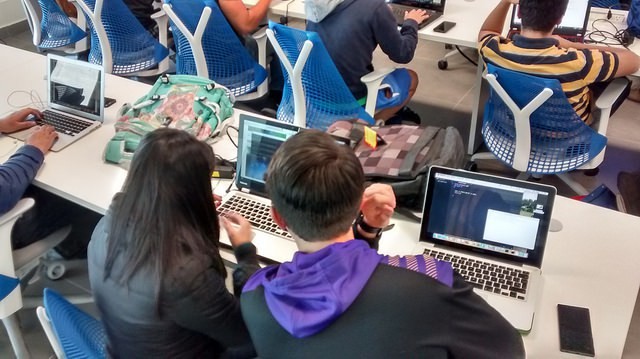
Bueno esto es un video sobre el curso en el que hablo sobre como es trabajar con ken Bauer que para mi ha sido un buen profesor, técnicamente no nos enseño a a hacer los trabajos que realizábamos durante el semestre pero nos enseño algo más importante, nos enseño a aprender por nuestra cuenta, a aprender apoyándonos en nuestros amigos, pues los seres humanos necesitamos de los demás, de hecho nuestras clases son multidisciplinarias y se supone que es para que aprendamos a trabajar en equipo, hagamos relaciones para cuando nos graduemos, para que sepamos que no somo unos sabe lo todo, o sea podemos saber mucho pero siempre va a haber alguien que sea mejor que tu en algún tema y tu mejor que otro en x o y cosa, necesitamos aprender a trabajar en equipo.
Ken trabaja de alguna forma como la Academia de Medicina del Itesm, con ABP (Aprendizaje a Base de Problemas) pues el nos da el “tema” y nosotros por nuestra cuenta investigamos y aprendemos, es una forma de no hacernos atenidos.
Link: VIDEO
Create a function called dot_product that receives two lists of numbers (say list1 and
list2). The function returns what is the dot product of the two lists.
For full marks, if the lists are not the same size, then the function should return the
special value of NaN (which represents not a number).
Example. If the input is [2,4,5,6] and [1,2,3,4] the result will be 49 since (2*1)+(4*2)+(5*3)+(6*4) = 49


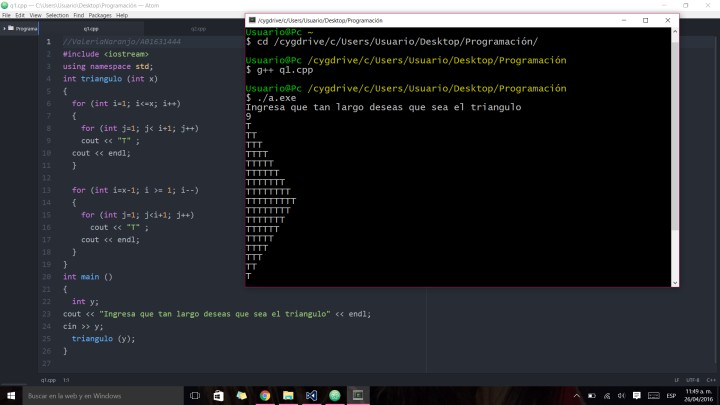
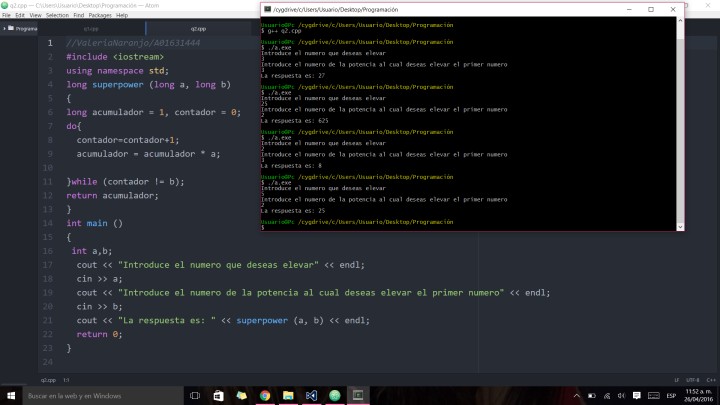
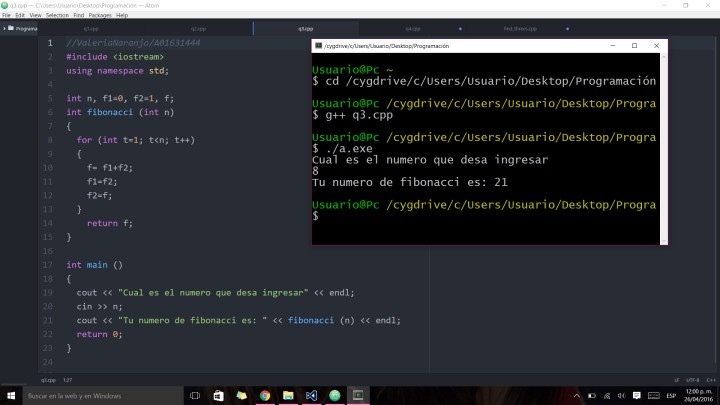
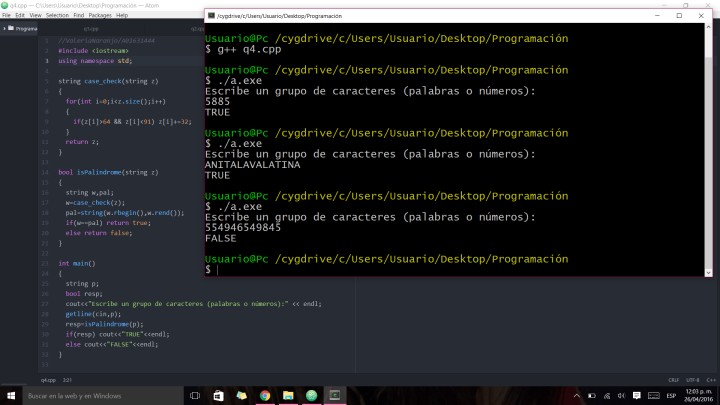
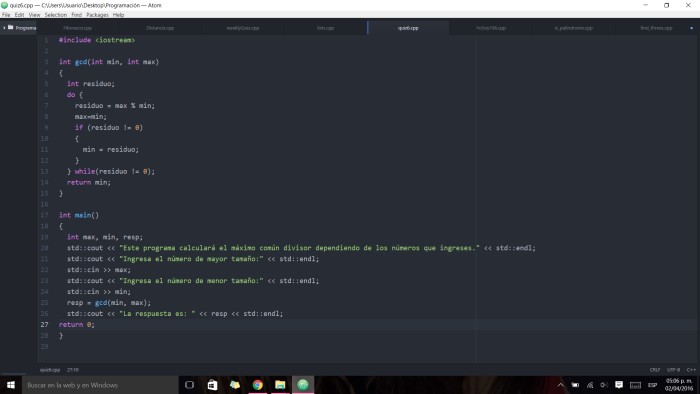
Este programa calcula el máximo común divisor de dos números que se le pide al usuario, uno de mayor tamaño y el otro de menor tamaño.
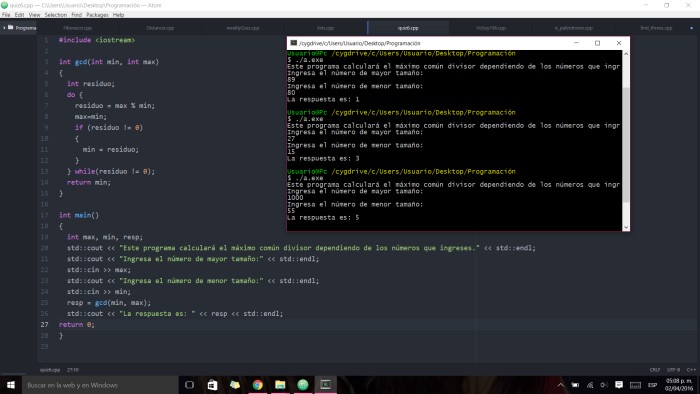
link: quiz6.cpp

En este programa se debía pedir una palabra, frase, numero o lo que fuera, para saber si era un palindromo, o sea si se leía igual de derecha a izquierda que de izquierda a derecha .

link : Palindrome.cpp

Este programa pide al usuario la cantidad de números que desea ingresar, siguiendo de introducir cada numero que desee, y arroja el resultado de la suma de los números que son divisibles entre 3.
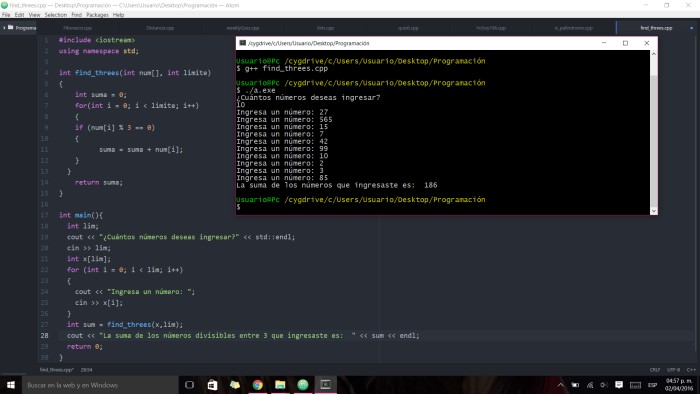
link : find_threes.cpp
1. The number e is an important mathematical constant that is the base of the natural logarithm. It is approximately equal to 2.71828,[1] and is the limit of (1 + 1/n)n as n approaches infinity, an expression that arises in the study of compound interest. It can also be calculated as the sum of the infinite series.

Source: https://en.wikipedia.org/wiki/E_(mathematical_constant
Create a function called euler_calc with a single parameter precision. The value of precision is used to determine when to stop calculating. Your calculation will stop when the two consecutive values estimating e differ by less than precision (remember to use absolute value when calculating the difference between two values here).


En este programa cree una función que se encarga de realizar el proceso para el numero de Euler, el programa recibe un valor dado por el usuario, este sera la cantidad de decimales que tendrá la respuesta, tantos decimales como pide el usuario es la exactitud del numero.
Como primer paso pedí el valor al usuario, después se definí la función, agregue el parámetro que debía recibir y lo empece a utilizar, al inicio con un pequeño ciclo que se encarga de detener el proceso del numero de Euler, luego agregue la función factorial de acuerdo al numero que va almacenando un contador y con otro contador se guarda el numero uno sobre su factorial según el numero de intentos, al final solo se imprimen los resultados.


Este programa solicita al usuario 10 números, los que este quiera, y arroja como resultado el total de la suma de los 10 números, el promedio de estos y la variación estándar que existe entre los números.

Aquí se puede apreciar los resultados correctos de cada una de las partes del programa.
link del programa: